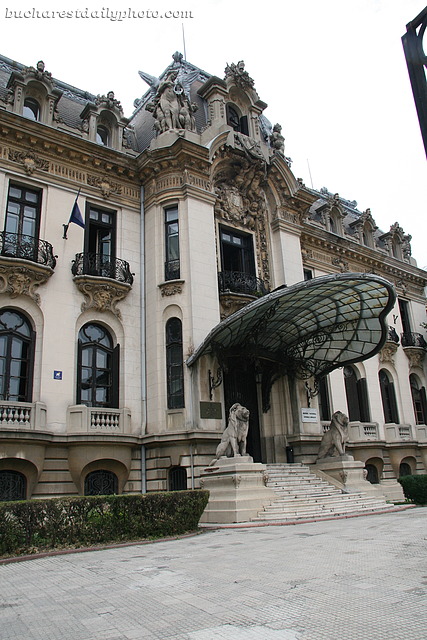Just so you don’t think that Bucharest is only made up of communist architecture, dangling cables and graffiti I decided that the time has come for me to post another postcard picture. This is Cantacuzino Palace, located on Calea Victoriei, designed by the architect I.D.Berindei in French Baroque style and built between the years 1899-1902. The facade is dominated by the main entrance; above it there is a giant shell-shaped porte-cochere and two stone lions guard the stairs and the door. George Enescu – Romania’s most famous composer – lived here for a while. The building belonged to his wife Maria Cantacuzino. In fact Enescu preferred a life of simplicity and he and his wife chose to live in a smaller town house that previously housed the administrative staff of the palace; this house is located behind the main palace. Nowadays the palace houses the George Enescu Museum which displays the musician’s manuscripts, scores of his compositions and personal belongings like one of his first violins. I still remember the impression it made on me when I saw the building for the first time. I think I was about ten when my aunt took me and my cousin on a stroll on Calea Victoriei. I thought that this must be the most beautiful building in the world 🙂
Sep 112009

The building is an absolute work of art! The entryway is fabulous!!
wow! is what i can say… that's my 1st impression when i saw your photo…^-^
although your history dictates communism, your architectural structure beg to differ…i love the entry fan shape roof, it's so art-nouveau inspired. ^-^
I must admit that if I had seen this photo on a wall somewhere outside Romania I would NEVER have guessed it's Romanian. Thank you for showing another side of your country. The entrance is spectacular! And I very much like the windows and balconies.
very nice picture indeed Andreea and of course it was a pleasure meeting you and Cris last night. Sanatate
Lovely building, perfect for a museum. I'm glad to know that Enescu is honored there, were he lived for a while. I was intrigued by the name of the palace, which sounds falsely Italian (literally 'sing cousin'), but of Greek origin.